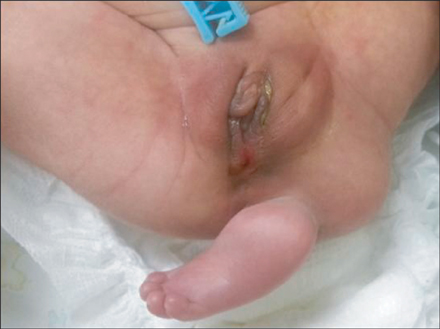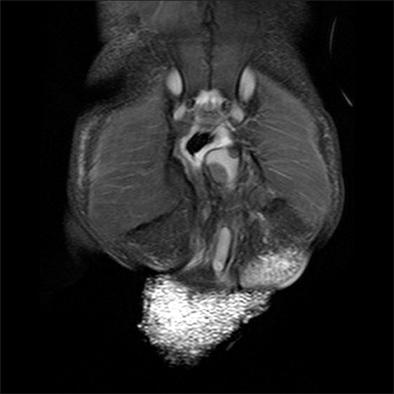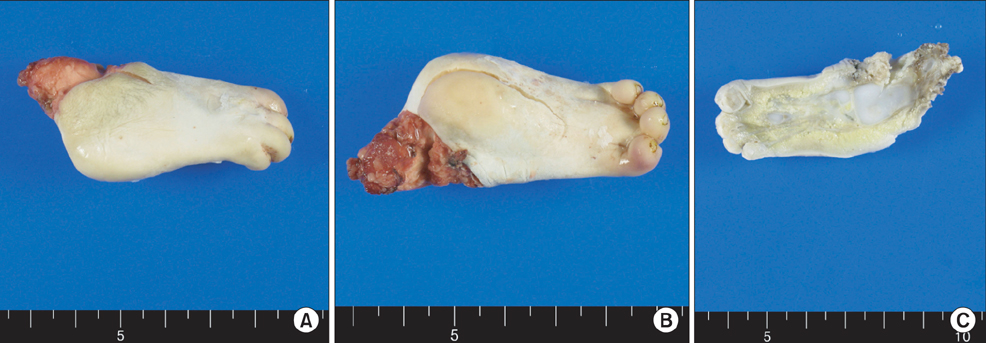Ann Surg Treat Res.
2014 Oct;87(4):213-216. 10.4174/astr.2014.87.4.213.
An accessory limb with an imperforate anus
- Affiliations
-
- 1Department of Orthopaedic Surgery, Inje University Haeundae Paik Hospital, Busan, Korea.
- 2Department of Pathology, Inje University Haeundae Paik Hospital, Busan, Korea.
- 3Department of Pediatrics, Inje University Haeundae Paik Hospital, Busan, Korea.
- 4Department of Pediatric Surgery, Inje University Haeundae Paik Hospital, Busan, Korea. namsh@paik.ac.kr
- KMID: 1882828
- DOI: http://doi.org/10.4174/astr.2014.87.4.213
Abstract
- Congenital accessory limbs are very rare anomalies with many causative factors. We describe the case of a 1-day-old female neonate-born to a healthy, 27-year-old mother-who presented with an accessory limb (foot) attached to the buttock and an imperforate anus. We also provide a review of the relevant literature.
Keyword
Figure
Cited by 1 articles
-
Polymelia (thoracomelia), an extremely rare appearance of congenital anomalic limb in a Nepalese child and its embryological basis
Ameet Kumar Jha, Samal Nauhria, Sabyasachi Maity
Anat Cell Biol. 2023;56(4):584-587. doi: 10.5115/acb.23.179.
Reference
-
1. O'Shea MK, Pillman SH, O'Shea R. Congenital third foot deformity: a case report. J Foot Ankle Surg. 2008; 47:583–588.2. Sharma L, Singh RB, Bhargava JS, Sharma VK. Accessory limbs with spinal lesions. Pediatr Surg Int. 1991; 6:227–229.3. Akyol D, Baltaci V, Kozinoglu H, Yuksel K, Kis S, Cicek N, et al. Accessory limb attached to the back. Turk J Med Sci. 1999; 29:199–201.4. Taniguchi K, Aoki Y, Kurimoto H, Okamura T. Baby with a third leg. J Pediatr Surg. 1975; 10:143–144.5. Chadha R, Bagga D, Malhotra CJ, Dhar A, Kumar A. Accessory limb attached to the back. J Pediatr Surg. 1993; 28:1615–1617.6. Rowe MI, Ravitch MM, Ranniger K. Operative correction of caudal duplication (dipygus). Surgery. 1968; 63:840–848.7. Unterscheider J, O'Byrne J, Foran A, Robinson I, Ryan S, Devaney D, et al. Prenatal identification of an accessory lower limb. Prenat Diagn. 2011; 31:1203–1204.8. Krishra A, Chandna S, Mishra NK, Gupta AK, Upadhyaya P. Accessory limb associated with spinal bifida. J Pediatr Surg. 1989; 24:604–606.9. Verma S, Khanna M, Tripathi VN, Yadav NC. Occurrence of polymelia in a female child. J Clin Imaging Sci. 2013; 3:18.
- Full Text Links
- Actions
-
Cited
- CITED
-
- Close
- Share
- Similar articles
-
- Two Experiences of Operation about Urogenital Anomalies Associated with Congenital Imperforate Anus
- A case of successful vaginal delivery in a patient with a repair of an imperforate anus
- Urogenital anomalies associated with imperforative anus
- A Case of Congenital Colonic Atresia Associated with Imperforate Anus
- Ultrasound measurement of pouch to perineum distance as a guide in determination of high or low imperforate anus







